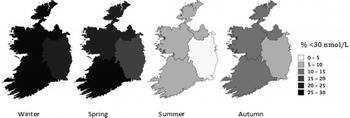Older adults (>50 yrs) are heavily dependent on sunshine exposure to contribute to overall vitamin D status( Reference Laird, Ward and McSorely 1 ). However, unlike the rest of the population, the ability for older adults to synthesize vitamin D is significantly reduced1. This coupled with age-related changes in metabolism such as increased food malabsoprtion, and dietary patterns characterized by a decrease in food quality, quantity and variety( Reference Power, Jeffery and Ross 2 ) leaves the older population at increased risk of vitamin D deficiency. However, few data are available examining the in-depth health, lifestyle, geographic and socio-economic determinants of vitamin D status exclusively in older adults.
The plasma concentration of 25-hydroxyvitamin D (25(OH)D) was measured by LC-MS/MS in 5,356 community dwelling older Irish adults (aged 50–98 yrs) from The Irish Longitudinal Study on Ageing (TILDA) cohort (Wave 1 data collection, 2009 to 2011), the largest nationally representative study of older adults in Ireland. Vitamin D containing dietary supplements and medications and detailed demographic, geographic and socio-economic factors were assessed by questionnaire. Proportions of vitamin D deficiency prevalence were generated by season sampled, geographic area (Figure 1) and by population characteristics. Linear regression was used to investigate the association between 25(OH)D concentration and demographic, geographic, health and lifestyle variables.

Fig. 1. Geographic and seasonal variation in the prevalence (% of population) of 25(OH)D deficiency (<30 nmol/L) in older Irish adults.
The prevalence of vitamin D deficiency (25(OH)D <30 nmol/L) was 13·1 % (95 % CI: 12·1–14·2) after seasonal adjustment. Deficiency status was more prevalent in non-supplement users, in winter months, in smokers, in obese adults, the physically inactive, those living alone and in the oldest old (>80 yrs). The main predictors (P<0·05) of 25(OH)D concentration were supplement use (coefficient nmol/L: 27·2 (95 % CI: 15·3 to 39·2)), smoking (−8·9 (−12·6 to −5·2), summer season (5·9 (2·7 to 9·1) and obesity (−4·0 (−6·3 to −1·7).
Vitamin D deficiency is common among older Irish adults. These data indicate the need for targeted strategies within sections of the older population to improve vitamin D status and the need for increased awareness of the factors that can increase the risk of deficiency.





